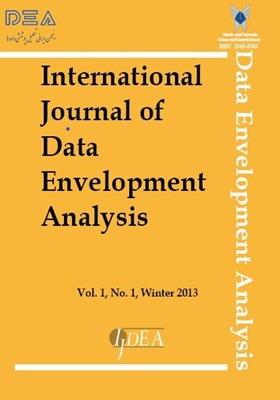Application of Machine Learning Models for flood risk assessment and producing map to identify flood prone areas: Literature Review
محورهای موضوعی : International Journal of Data Envelopment AnalysisParisa Firoozishahmirzadi 1 , Shaghayegh Rahimi 2 , Zeinab Esmaeili Seraji 3
1 - Delft University of Technology, Department of Water Management, Faculty of Civil
Engineering and Geosciences, Delft, Netherlands
2 - Department of Mathematics, University of Mazandaran, Iran.
3 - Department of healthcare, Islamic Azad University of Sari, Sari, Iran.
کلید واژه: Artificial Intelligence (AI), Decision Tree (DT), natural hazards & disasters, support vector machine (SVM), Artificial Neural Networks (ANNs), hydrologic model, ensemble Machine Learning, Keywords: Flood Risk Assessment (FRA),
چکیده مقاله :
Floods as the most destructive natural disaster are highly complex to model. The research on the advancement of flood risk assessment models contributed to risk reduction, policy suggestion, reduction of the property damage and minimization of the loss of human life. During the past two decades, machine learning methods contributed highly in the advancement of modeling systems, providing better performance and cost-effective solutions. Researchers through introducing novel ML methods and hybridizing of them aim at discovering more accurate and efficient models. The main contribution of this literature review is to demonstrate the state of ML models from two perspectives; 1-flood risk assessment, 2- producing flood reliable map to give insight into the most suitable models. In this literature is shown the important ML models that can have impressive effect on flood models are Super Vector Mane, Decision Tree, Logistic Regression and Random Forest respectively. Hybridization different kind of ML methods, data fusion that is a prevalent way to deal with imperfect raw data for capturing reliable, ensemble algorithm and model optimization are reported as the most effective strategies for the improvement of ML methods. Random Forest models do well with high dimensional data and their flexibility makes them suitable for solving more problems. ANN models are especially good at modeling multifarious nonlinear networks that are difficult to describe with functions directly. This study provides a concise and comprehensive reference for researchers
- Danso-Amoako, E.; Scholz, M.; Kalimeris, N.; Yang, ; Shao, J. Predicting dam failure risk for sustainable flood retention basins: A generic case study for the wider greater manchester area. Comput. Environ. Urban Syst. 2012, 36, 423–433.
- Xie, ; Ozbay, K.; Zhu, Y.; Yang, H. Evacuation zone modeling under climate change: A data-driven method. J. Infrastruct. Syst. 2017, 23, 4017013.
- Lohani, K.; Goel, N.; Bhatia, K. Improving real time flood forecasting using fuzzy inference system. J. Hydrol. 2014, 509, 25–41.
- Mosavi, A.; Bathla, ; Varkonyi-Koczy, A. Predicting the Future Using Web Knowledge: State of the Art Survey. In Recent Advances in Technology Research and Education; Springer: Cham, Switzerland, 2017; pp. 341–349.
- Zhao, M.; Hendon, H.H. Representation and prediction of the indian ocean dipole in the poama seasonal forecast model. J. R. Meteorol. Soc. 2009, 135, 337–352.
- Borah, D.K. Hydrologic procedures of storm event watershed models: A comprehensive review and Hydrol. Process. 2011, 25, 3472–3489.
- Costabile, ; Costanzo, C.; Macchione, F. A storm event watershed model for surface runoff based on 2D fully dynamic wave equations. Hydrol. Process. 2013, 27, 554–569.
- Cea, L.; Garrido, M.; Puertas, J. Experimental validation of two-dimensional depth-averaged models for forecasting rainfall–runoff from precipitation data in urban areas. Hydrol. 2010, 382, 88–102.
- Fernández-Pato, J.; Caviedes-Voullième, D.; García-Navarro, Rainfall/runoff simulation with 2D full shallow water equations: Sensitivity analysis and calibration of infiltration parameters. J. Hydrol. 2016, 536, 496–513.
- Caviedes-Voullième, ; García-Navarro, P.; Murillo, J. Influence of mesh structure on 2D full shallow water equations and SCS curve number simulation of rainfall/runoff events. J. Hydrol. 2012, 448, 39–59.
- Costabile, P.; Costanzo, C.; Macchiono, F. Comparative analysis of overland flow models using finite volume schemes. Hydroinform. 2012, 14, 122.
- Xia, X.; Liang, Q.; Ming, X.; Hou, J. An efficient and stable hydrodynamic model with novel source term discretization schemes for overland flow and flood simulations. Water Resour. Res. 2017, 53, 3730–3759.
- Liang, X.; Lettenmaier, D.P.; Wood, E.F.; Burges, S.J. A simple hydrologically based model of land surface water and energy fluxes for general circulation models. Geophys. Res. Atmos. 1994, 99, 14415–14428.
- Costabile, P.; Macchione, F. Enhancing river model set-up for
2-D dynamic flood modeling. Model. Softw. 2015, 67, 89–107.


